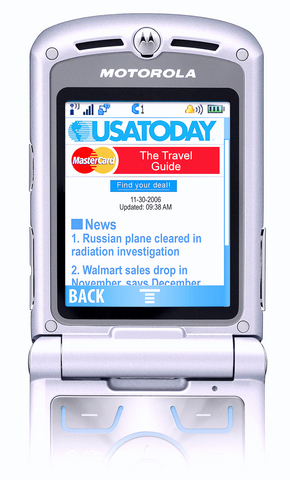People often say they do not like advertisements, but that may change if the ads start lowering their cellphone bills.
Cellular phone carriers like Verizon, Sprint and Cingular -- now the new AT&T -- are beginning to test and roll out advertising on mobile phone screens, but by next year, cellphone advertising is likely to be more common.
In exchange, the companies say, their subscribers will enjoy improved mobile Internet services and content provided free or at reduced prices. Other companies, like Virgin Mobile USA and Amp'd Mobile, are taking the idea a step further, rewarding customers for viewing ads by lowering their cellphone bills.

PHOTO: NY TIMES NEWS SERVICE
Amp'd, a cellphone company that aims its marketing at 18 to 24-year-olds in the US, will begin offering an opt-in advertising plan this year.
Customers who sign up will gain access to free shows and other content -- if they are willing to put up with some ads.
"When people are consuming this stuff on their phones, it adds up to a lot of money," said Brian Mullen, director for content business development for Amp'd.
Another company, Xero Mobile, plans to distribute 1 million free cellphones on college campuses across the US this year and give customers 40 percent off on their calling plans if they watch up to four commercials a day, said Rich Clayton, a spokesman for Xero.
In Britain, a company called Blyk plans to provide a completely free plan on phones that are paid for by ads.
It was inevitable that advertising would hit the small screen sooner or later, industry analysts said. Cellphones are the most pervasive media device, beating out computers and TVs, as consumers keep their mobile phones at their side nearly every moment of the day.
A small but growing number of consumers -- younger ones, in particular -- are using their mobile phones for text messaging, surfing the mobile Internet, watching short shows, taking photos or videos and checking e-mail messages. Only time will tell if cell phones are destined to become -- like all other forms of media -- supported by both subscription costs and by advertising.
Still, these new phone services will become mainstream only if their prices are lowered, possibly through advertising, analysts said. On average, consumers in the US spend US$50 to US$60 a month for cellphone service, including data features. The average total bill has been flat for the last few years, even as voice call charges have decreased, because of the increase in fees for text messages, mobile e-mail messages.
"Advertising absolutely makes sense to extend expensive multimedia services and mobile TV to the mass market," said Linda Barrabee, an analyst with the Yankee Group, a technology research and consulting firm based in Boston.
"I think we will see consumers say, `You know what, I'm only going to spend this much money on my mobile phone,'" she added.
In Asia, by contrast, multimedia mobile applications are more commonly used and those services became more affordable without advertising because of quick adaptation by consumers, analysts said.
The new uses of cellphones present vast opportunities for companies, which are finding it difficult to reach customers through traditional media like magazines and TV. Mobile phones can handle ads in many forms, including video, text messages, search and banner displays. And cellphone ads can be fine-tuned based on customer data.
But there is a chicken-and-egg factor when it comes to advertising.
Big advertisers generally want to see further adoption of services before they pour significant money into mobile ads.
Advertisers like Procter & Gamble, Burger King and Pepsi have been experimenting with mobile phone ads, but, in total, cell phone advertising generated only about US$421 million in the US last year, said eMarketer, a digital advertising research firm. EMarketer predicted this month that mobile advertising would reach US$4.8 billion across the country by 2011.
Despite the hopeful thinking, there is no guarantee mobile ads will catch on.
"I would not want them on the phone even if that would help cut costs," said Conor Kelly, 20, a student at Savannah College of Art and Design in Georgia. Kelly said he did not mind subtle sponsorships of content on his phone, but he would not want it go beyond that.
"It gets to a point where you're almost encroaching on someone's privacy," he said.
In the early days of the Internet, several Internet service providers tried giving away online access in exchange for showing ads to users, but those efforts did not pan out.
For the subsidized approach to work this time around, cellphone companies must prove that consumers pay attention to ads.
"We have to ensure that the models that we pursue are those that actually get seen and acted on by consumers," said Marc Lefar, chief marketing officer for AT&T's wireless unit, which used to be called Cingular Wireless.
AT&T is testing various forms of cellphone advertising, with introduction of ads planned this year.
Text messaging is the most common venue for mobile phone ads. Signs, food packaging and even TV spots feature a code that phone users can text to be entered in promotions. 1-800-Flowers, for example, is running a sweepstakes in the New York area for a flower arrangement that comes in a small margarita glass.
Next week, Nike will allow consumers to mash up one of its TV commercials online and send their creations to their friends' phones.
Some consumers may not realize that opt-in text message ads generate a charge for those who pay for each incoming text message. Such costs have deterred some marketers from creating mobile ads, said Sarah Kim Baehr, vice president for media at Avenue A Razorfish, an interactive ad agency that is part of aQuantive.
As mobile phones become used for more tasks, ads will pop up increasingly in more varied forms, ad executives said.
Advertisers like Toyota have created 10-second commercials to run before miniepisodes of Fox shows, which the network promotes as a great way to reach a young audience.
"Look around," said Mitch Feinman, senior vice president Fox Mobile Entertainment. "All the young males and kids, they're on their mobiles."
Advertisers are generally paying a high price to try cellphone ads, about US$40 for a thousand viewings of their ads, or twice as much as many TV spots, analysts said.
The performance of these ads over the next year or so will determine whether they are likely to provide enough income to justify giving customers a price break on service fees.

MORE VISITORS: The Tourism Administration said that it is seeing positive prospects in its efforts to expand the tourism market in North America and Europe Taiwan has been ranked as the cheapest place in the world to travel to this year, based on a list recommended by NerdWallet. The San Francisco-based personal finance company said that Taiwan topped the list of 16 nations it chose for budget travelers because US tourists do not need visas and travelers can easily have a good meal for less than US$10. A bus ride in Taipei costs just under US$0.50, while subway rides start at US$0.60, the firm said, adding that public transportation in Taiwan is easy to navigate. The firm also called Taiwan a “food lover’s paradise,” citing inexpensive breakfast stalls

TRADE: A mandatory declaration of origin for manufactured goods bound for the US is to take effect on May 7 to block China from exploiting Taiwan’s trade channels All products manufactured in Taiwan and exported to the US must include a signed declaration of origin starting on May 7, the Bureau of Foreign Trade announced yesterday. US President Donald Trump on April 2 imposed a 32 percent tariff on imports from Taiwan, but one week later announced a 90-day pause on its implementation. However, a universal 10 percent tariff was immediately applied to most imports from around the world. On April 12, the Trump administration further exempted computers, smartphones and semiconductors from the new tariffs. In response, President William Lai’s (賴清德) administration has introduced a series of countermeasures to support affected

CROSS-STRAIT: The vast majority of Taiwanese support maintaining the ‘status quo,’ while concern is rising about Beijing’s influence operations More than eight out of 10 Taiwanese reject Beijing’s “one country, two systems” framework for cross-strait relations, according to a survey released by the Mainland Affairs Council (MAC) on Thursday. The MAC’s latest quarterly survey found that 84.4 percent of respondents opposed Beijing’s “one country, two systems” formula for handling cross-strait relations — a figure consistent with past polling. Over the past three years, opposition to the framework has remained high, ranging from a low of 83.6 percent in April 2023 to a peak of 89.6 percent in April last year. In the most recent poll, 82.5 percent also rejected China’s

PLUGGING HOLES: The amendments would bring the legislation in line with systems found in other countries such as Japan and the US, Legislator Chen Kuan-ting said Democratic Progressive Party (DPP) Legislator Chen Kuan-ting (陳冠廷) has proposed amending national security legislation amid a spate of espionage cases. Potential gaps in security vetting procedures for personnel with access to sensitive information prompted him to propose the amendments, which would introduce changes to Article 14 of the Classified National Security Information Protection Act (國家機密保護法), Chen said yesterday. The proposal, which aims to enhance interagency vetting procedures and reduce the risk of classified information leaks, would establish a comprehensive security clearance system in Taiwan, he said. The amendment would require character and loyalty checks for civil servants and intelligence personnel prior to